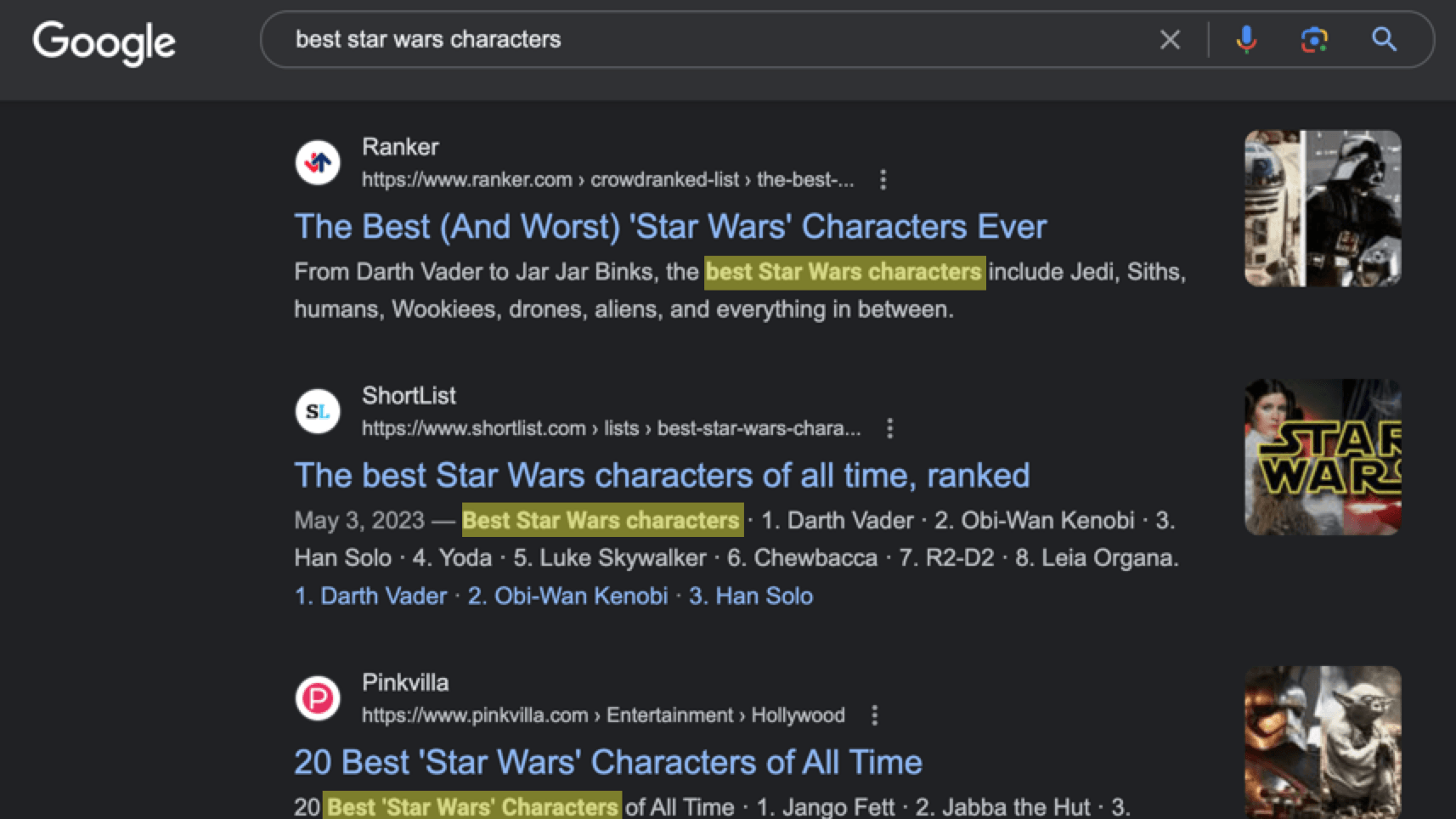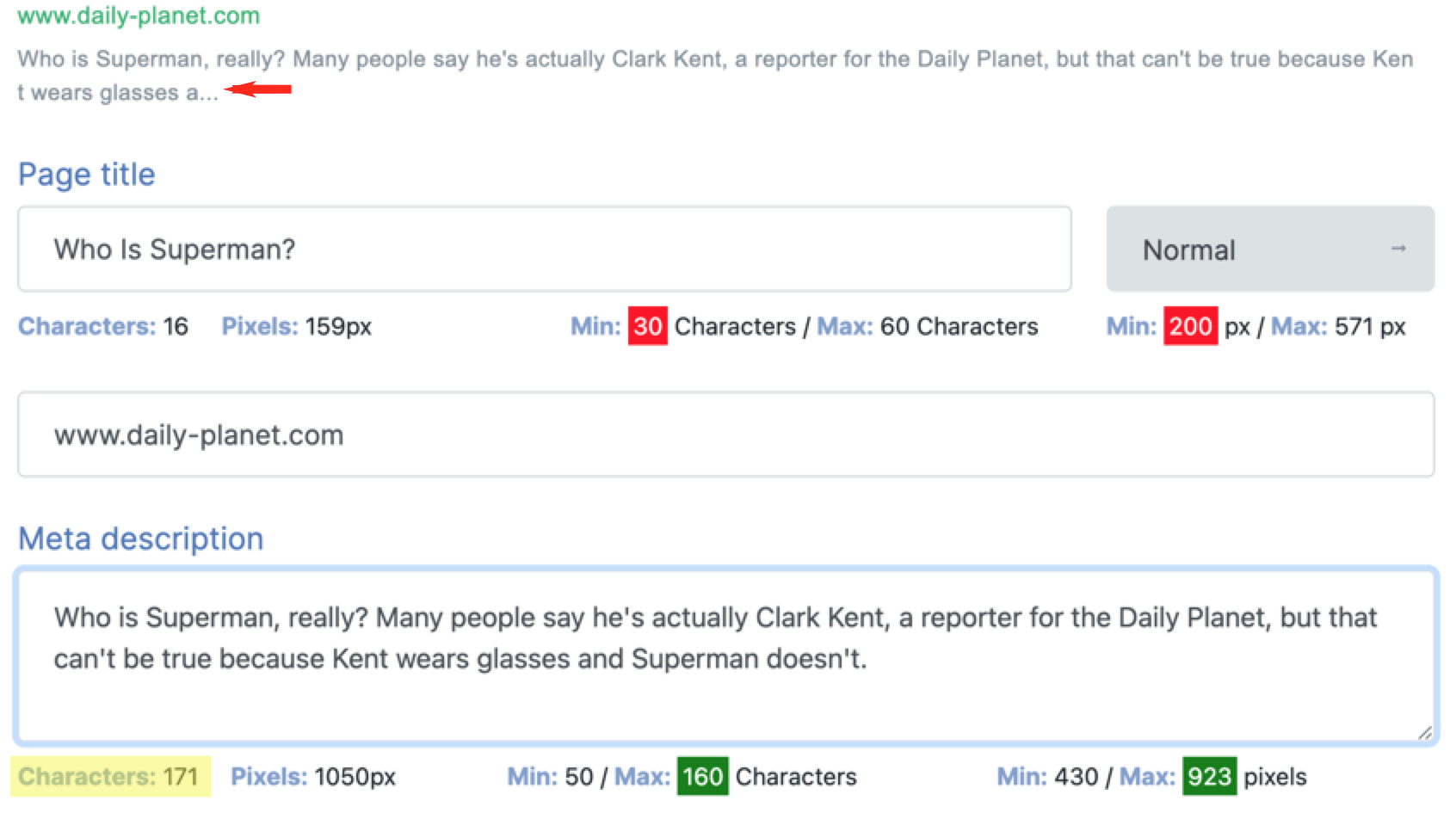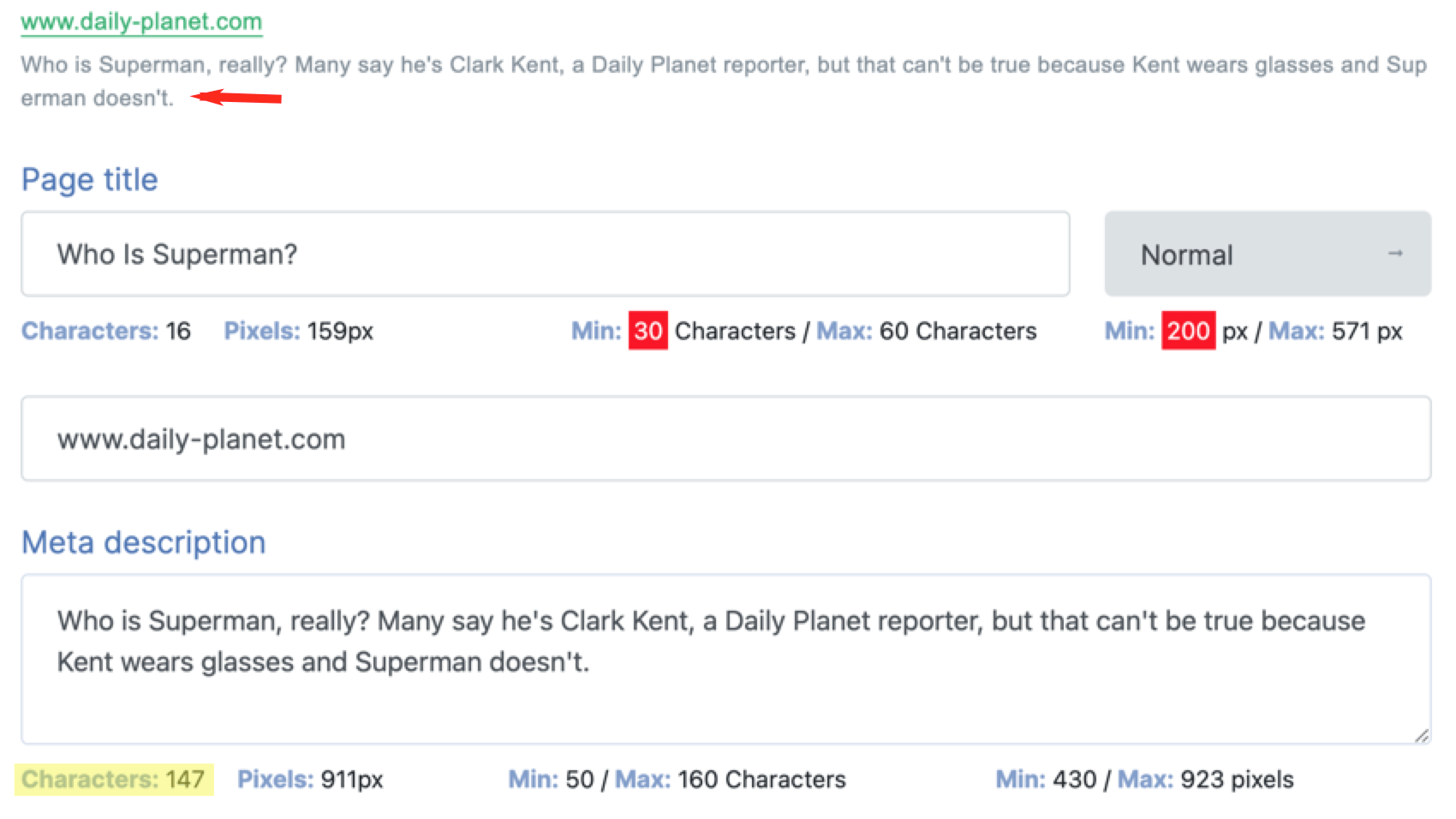Master the basics of meta descriptions, from what they mean to how to write them, now!
What is a meta description?
A meta description is an HTML tag (<meta name=”description” content=”add your meta description here”>) that summarizes the URL’s content. This description then appears in search results, below a page’s title tag and URL.
In some instances, search engines like Google will rewrite meta descriptions.
What is an example of a meta description?
Below is an example of a meta description in Google’s search results.

Why are meta descriptions important?

“Meta description tags are important because Google might use them as snippets for your pages in Google Search results.”
There are a few reasons meta descriptions are important for SEO:
Keyword relevance
Like other on-page signals, from title tags to headings, meta descriptions help search engines (and users) understand a page’s relevance to a search term, like “dairy-free pumpkin pie recipe.”
When you write meta descriptions that describe your page and use your targeted keywords, you can signal to Google (and other search engines) that your page answers the targeted intent.
Click-through rate (CTR)
Meta descriptions can influence SEO rankings by improving your CTR.
When looking through search results, meta descriptions are the first pieces of text that give users a taste of what’s on your page. Users look at them when deciding whether to click on your page.
The more enticing your meta description, the more likely you are to attract valuable traffic to your site.
Keyword rankings
Meta descriptions aren’t a top ranking factor in SEO.
However, they do play a role, which is why it’s important to optimize your meta descriptions for SEO. We’ll talk about this more in a later section on how to write meta descriptions, but using your target keyword can support higher keyword rankings.
Meta description best practices
Now that you’ve learned the meaning of meta descriptions, let’s explore its best practices:
- Length: The optimal length for meta descriptions is between 70 – 155 characters.
- Integration: A meta description should include the page’s target keyword.
- Format: A meta description should summarize the page and include a call-to-action (CTA).
- Uniqueness: All meta descriptions on a site should be unique vs. duplicates.
How to write meta descriptions for SEO
Learn how to write meta descriptions for SEO now:
1. Answer the search intent
People turn to search engines to find answers to questions, and they rely on meta descriptions to help them determine if a page holds the answers.
By answering search intent in your meta description, you can show users that your page fulfills that user’s needs.
For example, look at the difference between a meta description that ignores search intent and one that answers it.
Bad meta description:

This meta description does nothing to answer user search intent (learn a potato stew recipe), focusing on the chef’s love for potatoes instead. While wholesome, it doesn’t help users looking for a potato stew recipe.
Good meta description:

Here, the meta description addresses search intent by showing users exactly what they want.
2. Include the targeted keywords
This next meta description best practice is essential to your page’s SEO performance. When writing your meta description, incorporate the page’s target keyword to ensure it appears on the appropriate search results page.
Search engines like Google bold keywords that appear in meta descriptions, capturing users’ attention while scrolling through search results. For example, notice how results stand out when they use the search query’s keywords in their meta descriptions:

3. Prompt users to click with a CTA
Along with getting users’ attention, your meta description should inspire them to take action. To do this, you can include a CTA in your meta description.
For example, if you’ve created a list of the best places in your area to buy local produce, you may include a CTA that says, “Visit these local produce vendors in [Location].”
CTAs give users a clear next step to follow and urge them to complete an action that benefits your business. In this case, it’s getting users to visit your website. See how much of a difference a CTA can make in a meta description by reading the following two examples.
Bad meta description:

In this example, the meta description is missing a CTA, leaving no clear next step for users.
Good meta description:

In this example, users are urged to learn more about different vacation destinations.
4. Use a meta preview tool to monitor character count
Finally, when learning how to write great meta descriptions, use a meta preview tool to help you stay within character count. Remember, after 155 characters, Google may cut off part of your meta description, so it’s a good idea to use preview tools to ensure your writing won’t get cut off on Google.
Meta preview tools show you how your meta description will look on Google’s search results once published. For example, WebFX’s Google Preview Tool lets users preview their page’s meta, title tags, and site URLs to get an accurate picture of how it’ll look on Google’s results pages once published.
While going over 155 characters may not seem like a big deal, even just one or two additional characters can affect how your meta description appears on Google.
Bad meta description:

Though this meta description example is so many characters over 155, some words at the end are cut off in the preview.
Good meta description:

Safely within the 155-character limit, this meta description is displayed in the preview.
5. Generate ideas with AI
If you’re not a writer, you’re not alone.
That’s where AI tools like ChatGPT or Claude can help. You can use these free platforms to generate ideas for meta descriptions. Keep in mind, though, that AI cannot count characters, so most of these meta descriptions will exceed 155 characters.
If you plan on using these meta descriptions, proof them to ensure they:
- Describe the content
- Use the targeted keyword
- Conclude with a CTA
You can also generate meta descriptions programmatically using a Google Sheet.
Craft attention-grabbing meta descriptions with SEO.com
At SEO.com, we have over 25+ years of experience helping clients accelerate their SEO campaigns with on- and off-page and technical optimization services, SEO audits, and more.
See how our team of SEO professionals can help you write great meta descriptions that help improve your SEO performance by contacting us online today.
Let’s Drive Results Together 
FAQs
Learn more about meta descriptions with these FAQs:
How long should a meta description be?
A meta description should be between 70 – 155 characters.
Why is Google rewriting my meta descriptions?
Google rewrites meta descriptions over 70% of the time, so don’t be alarmed when you see the search engine rewriting yours. According to John Mueller (a member of the Search Relations Team), Google rewrites meta descriptions for a few reasons, including:
- The meta description is not provided
- The meta description is spammy
- The meta description isn’t useful to users
- The meta description isn’t as relevant to the search intent
You can troubleshoot most of these issues. Some, however, are difficult because users can find your content through a variety of searches. In these instances, Google rewriting your meta description can actually make your description more compelling and relevant.
Table of Contents
- What is a Meta Description?
- What is an Example of a Meta Description?
- Why Are Meta Descriptions Important?
- Keyword Relevance
- Click-through Rate (CTR)
- Keyword Rankings
- Meta Description Best Practices
- How to Write Meta Descriptions for SEO
- 1. Answer the Search Intent
- 2. Include the Targeted Keywords
- 3. Prompt Users to Click with a CTA
- 4. Use a Meta Preview Tool to Monitor Character Count
- 5. Generate Ideas with AI
- Craft Attention-grabbing Meta Descriptions with SEO.com
- FAQs
- How Long Should a Meta Description Be?
- Why is Google Rewriting My Meta Descriptions?
Let’s Drive Results Together 
Writers

Related Resources
- The Basics of Registered Trademarks & Symbols in Title Tags
- The Ultimate SEO Keyword Research Guide in 2025
- What Are Internal Links? A Guide to Internal Linking Basics
- What Are Low-Hanging Fruit Keywords and Why Do They Matter?
- What is an SEO Score? Definition, Factors, and How to Improve
- What is First Link Priority? (And Does It Affect Rankings?)
- Why is Google Ignoring My Title Tag and Meta Description?
- 100+ Best SEO Keywords for Ecommerce Businesses
- 100+ Best SEO Keywords for HVAC Companies
- 100+ Best SEO Keywords for Manufacturing Companies


